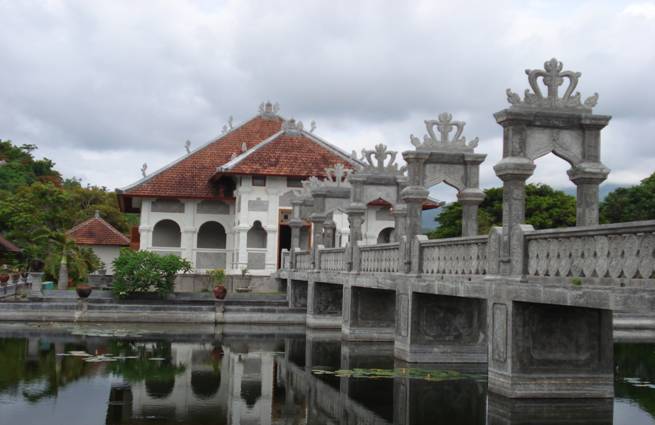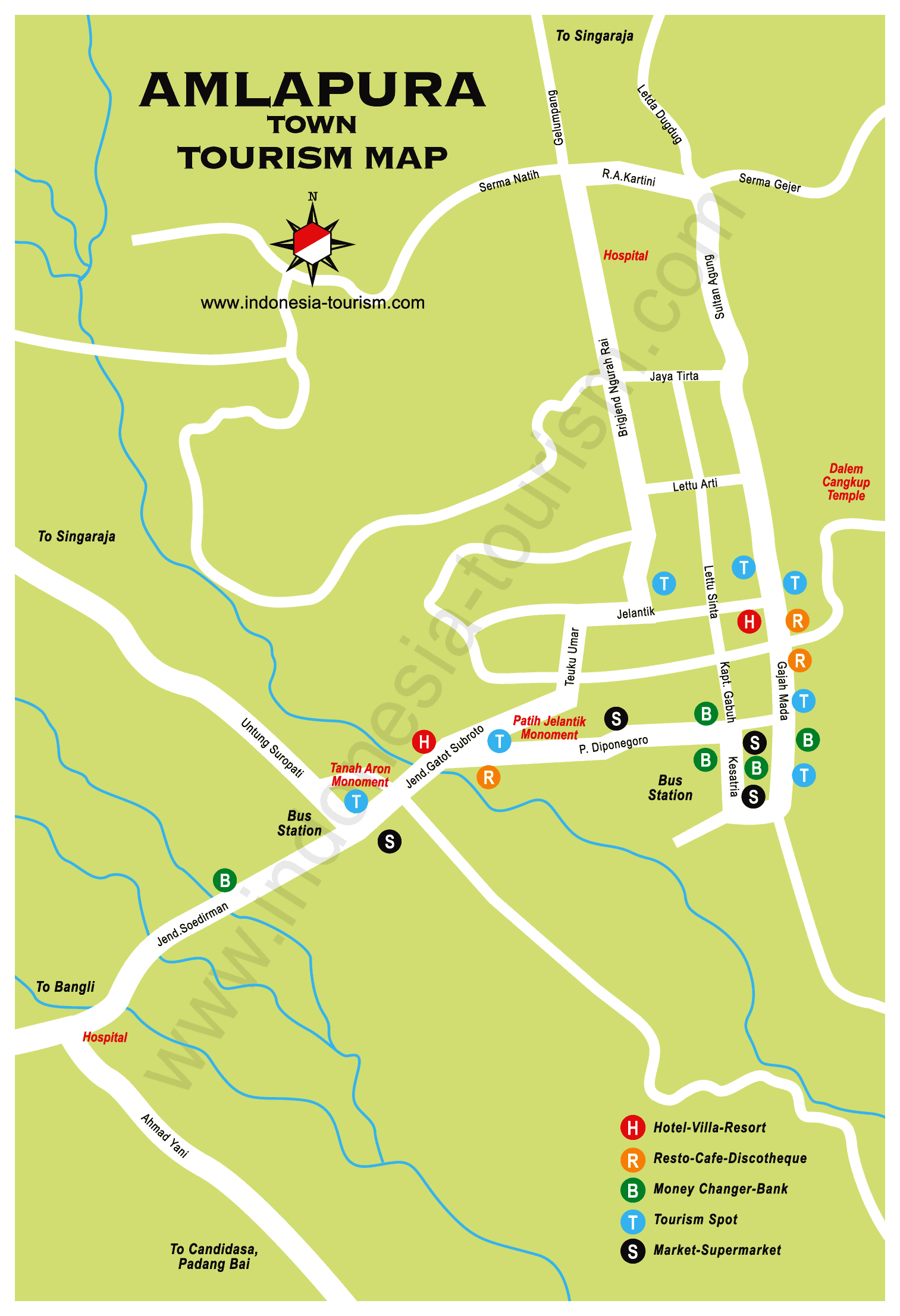Capital : Amlapura
Highest Peak : Mt. Agung – 3.142 meters above sea level
Location : Eastern Bali
Land Area: 839,54 sq. km.
No. Of Districts : 8 (Abang, Babandem, Karangasem, Kubu, Manggis, Rendang, Selat & Sidemen)
Important Phone Numbers :
Direct Inquiries : 0363 21108
Karangasem Tourist Office Address : Jl. Diponegoro – Amlapura.
Phone : 0363 – 21196
General Information
The regency of Karangasem is one of the nine regency in Bali, situated in the eastern part of Bali , covering an area of 839, 54 sq. kilometers. Karangasem itself consist of eight Districts namely: Karangasem, manggis, Rendang, Selat, Sidemen, Bebandem, Abang, and Kubu District. Karangasem has an extraordinary variety of scenic landscapes. Low and high mountain ranges intermingle with upland plain, tropical forests, teracced rice field, beautiful beaches, culture and history archeological remains, traditional ” Bali Aga” village with their way of life make Karangasem worth visiting.
It is very easy to reach all of the interesting places in Karangasem which are supported by fairly good road conditions, facilities such at hotels, restaurants, money changers, souvenir shops and others which would you expect in a tourist environment. Expanding in Rendang, Muncan, Nyuh Tebel, Tianyar etc. The center of unit effort of this type not less 272 units, permeated 1.100 employees which production per year about 37,842 valuable reach Rp. 1,234,500,000,-. Matting of Screw Pine type of enviromental friendly matting exploit local potency of tree of this screw pine even nowadays expand and can be able to penetrated compartment of market export and local.
Production of this matting is designed in the form of artistic masterpiece of bag, place tissue, map, purse, slipper, pallet of glass with centre area in Tumbu village, subdistrict of Karangasem. Has notice that the amount of unit this effort about 451 units, permeated 480 employees, with capacities of production 105,000 values range about Rp. 525,000,000,-. Sibetan is centre of Salak (skin snack fruit) commodities center that nowadays become to agro-tourism area supported by beautiful view in hamle Moding top. Here also can be witnessed traditional conservation of salak at one blow can enjoy this production and bring it home as souvenir.
Overview
The best known spot in the Karangasem regency is perhaps Besakih, Bali ‘s mother temple. There are, however, many other objects worth visiting, such as Bukit Jambul Hill, on the road between Klungkung and Besakih, 12 kilometers north of Klungkung. Restaurant and coffee-shops are available. Not far from here, about 60 kilometers away from Denpasar or 13 kilometers from Klungkung, is Besakih Bali’s mother temple. It consists of 18 temple complexes. Besakih lies on the slope of Mount Agung . At an altitude of about 1,000 meters above sea level.
The three main temples are Batu Madeg in the northwest, Kiduling Kreteg in the south, and Penataran Agung in the middle, dedicated to Shiva, the destroyer. Small temple groups are Basukian (Naga Dunia), Bangun Sakti and Manik Mas, Fifty-five different ceremonies are held here avery years, but the most important of all is Betara Turun Kabeh, held every full moon of the tent onth of the Balinese lunar calendar, when all the gods descend to the earth. Other important ceremonies are Panca Wali Krama (one every 10 years) and Eka Dasa Rudra (one in century).Candi Dasa Temple is found on the roadside between Denpasar and Amlapura, 64 kilometers from Denpasar.
A Hariti Statue, representing a woman surrounded by children, is kept in the temple. Tenganan or Tenganan Pegringsingan is a village lying 66 kilometers to the northeast of Denpasar. The village is famed for the very fine gringsing ikat textiles that are handwoven there by village women. The village is mentioned in an inscription on stone, dating from the 11 th century which wasfound at Ujung. Tenganan was previously named Panges, and according to legend, its people come from a place on the coast, near the Dasa Temple . The village is backed by hills on three sides. The only access is from the south, where there are no hills.
A kind of fortification surrounds the village. There are three court yards, which divide this village into three banjar’s (small community units): the Banjar Kauh in the west, the Banjar Tengah in the middle and the Banjar Pande in the east. The village community hall, youth hall, rice barn and temple are fond in the middle. The houses stand in rows and from outside look as if they are connected to each other east house it own door. One chamber in each house is reserved for religious rituals. The people of Tenganan are regarded as the original inhabitants of Bali and are called the Bali Age. Their customs and traditions are governed by regulations known as Awig-awig.
One religious ceremony that is most interesting to watch is kare-kare, in which young men engage each other in a ceremonial fight, using thorny pandanus leaves as weapons. The inhabitants of Tenganan are very religious people. Almost their whole life is dedication to worship. Various rites and ceremonies are known. The most important one is held every 16 th , 17 th , and 18 th of Jue, and is called the Sasih Sada ceremony. It is dedicated to Dewa Indra, the god of prosperity. During this ceremony, men and women wear gringsing cloth, because in their belief this will protect them against evil.
The process of making Gringsing is very long and complicated, so the cloth is very expensive. Gringsing cloth belongs to the double ikat category , in which the design is carried by both the warp and the woof. The process of dyeing takes a long time. To obtain the color yellow, the yarn must be soaked for a month and seven days. To obtain black, it must be soaked for a month. Red is obtained from Sunti wood. The yarn is soaked for three days, and then dried in the sun. Three months later, it is processed again. It is said that the making of one piece of quality Gringsing cloth takes eight to 12 years.
The caste system or social stratification is not known here. The one god worshipper is Dewa Indra. The dead are laid to rest without any clothes on, in the same state as when he was born. The body is allowed to remain in the house for a night only. Lontar-leaf manuscripts are another product, besides gringsing textiles, for which Tenganan is known. Bukit Gunung Temple is found in Bugbug Village 68 kilometers from Denpasar. A unique event during the temple festival in this temple is Dewa Mepalu, or the fight between gods. Putung Village, in the Karangasem Regency, is known for its sacred Sanghyang Dance.
It is usually performed during temple festivals, which take place once in very six months, It is a trance dance in which the dancers trample on glowing coals and dance standing on another dancer’s shoulders.The holy Temple of Karangasem is in the center of Amlapura, the capital of the Karangasem regency, 78 kilometers from Denpasar. The temple was built in 1909 by A Toana, a European. There is a pond in the temple yard, surrounded by pavilion s. The names of main pavilions are Amsterdam Hall and London Hall. Taman Ujung Park , five kilometers south of Amlapura, was in the past a pleasure garden of the kings of Karangasem.
There is a lotus pond in the park and the building display a blend of Balinese and European influence. Tirta Gangga, a beautiful park surrounded by paddies is six kilometers north of Amlapura. There is a mountain in the middle of a pond. Tirta Gangga was built by the King of Karangasem, A.A. Anglurah Ketut Karangasem, in 1946. About 25 kilometers from Amlapura, is Tulamben Beach . The wreckage of a old ship lies a the bottom of the sea and makes a favorite target for divers. Iseh Village lies in the Sidemen district, 20 kilometers from Karangasem, with very attractive surroundings.
The village is a popular holiday resort Religious ceremonies, such as Usaha Dangsil, are often held at Bungaya Village in the middle of the month of August. The village is known for its crafts and dances (Pendet and Rejang). Kambing Island is an attractive resort for recreation and diving. The submarine gardens are beautiful. Sibetan village is known for its sweet salak (snake fruits)
History
The state of Karangasem, on the island of Bali, was in existence by the middle of the seventeenth century. The dynasty claims descent from the last Mahapajit Governor of Bali at the time of the collapse of that Empire. The state became powerful during the late seventeenth century, conquering the neighbouring Lombok and establishing several principalities on that island. During the last years of the next century, Gusti Gede Ngurah Karangasem [Devata Tohpati], extended control over Buleleng. The state was conquered by the Raja of Mataram, a collateral relative in 1839.
The next ruler, Gusti Gedé Ngurah Made Karangasem, accepted Dutch sovereignty over his realm in 1841, but later repudiated this, along with the other Balinese Rajas. Karangasem and Buleleng suffered completed defeat at Dutch hands during the Lombok War in 1849. The Dutch then annexed the state to the Ratu Agung of Salaparang, their ally. He appointed two of his nephews as successive Regents of Karangasem. After the defeat and extinction of Salaparang in 1893, the Dutch re-established the Karangasem principality under the ruler of the late Regent’s family. However, full self-rule did not follow until 1938.
The principality acceded to the Indonesian Republic in 1950, but the Raja continued to reign as nominal Raja until his death in 1991. His younger brother succeeded him as Head of the Royal House, but his installation, according to traditional custom, did not follow.
Place of Interest in Karangasem Regency :
- Amed Beach
- Besakih Temple (Mother Temple of Bali)
- Bukit Jambul
- Candidasa Beach
- Mount Agung
- NorthEast Coast Diving
- Padangbai Harbor
- SouthEast Coast Diving
- Taman Ujung Soekasada
- Telagawaja River
- Telagawaja Rafting Adventure
- Tenganan Village
- Tirta Gangga
- Tulamben Beach
(click Image to Enlarge)


